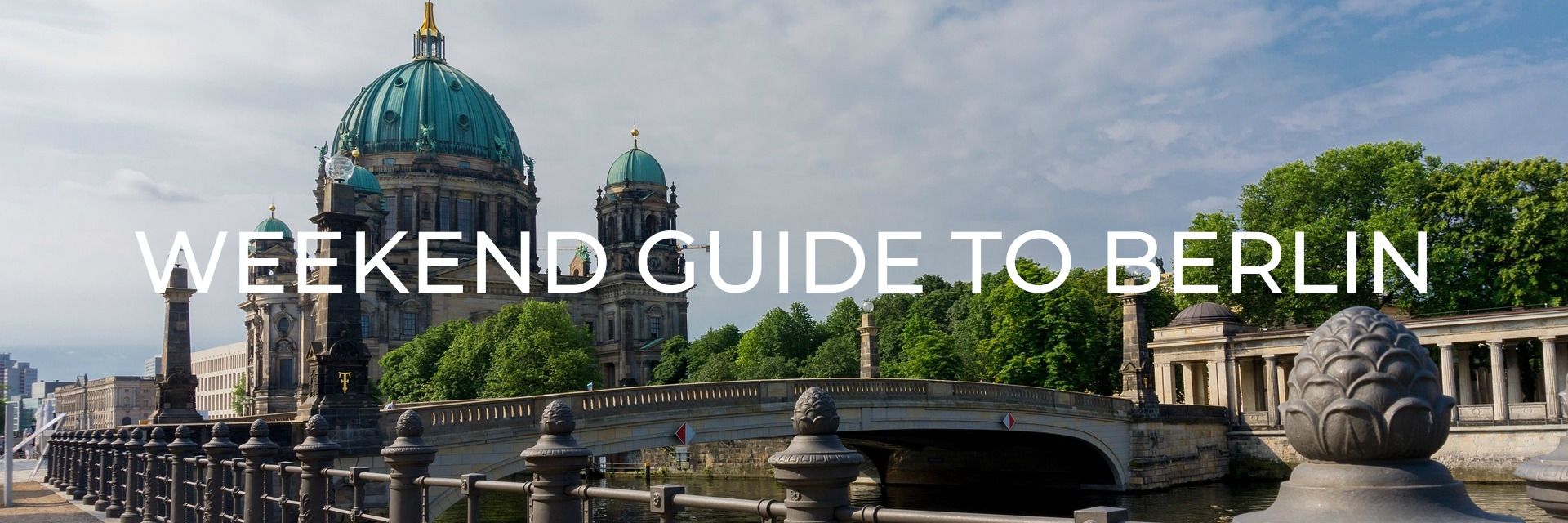
In Berlin there is always so much to see and do, every day of the year and any time of the day or night; it is full of culture, sites and events. It is an exciting modern city with a fascinating, although troubled, past that attracts visitors from all over the world.
From its moving memorials and beautiful historical architecture to its happening clubs, eateries, and places to shop – Berlin has it all and is a fantastic city to visit and explore for a weekend getaway.
Want to save this for later? Click the Pinterest button on the left for a pinnable image!
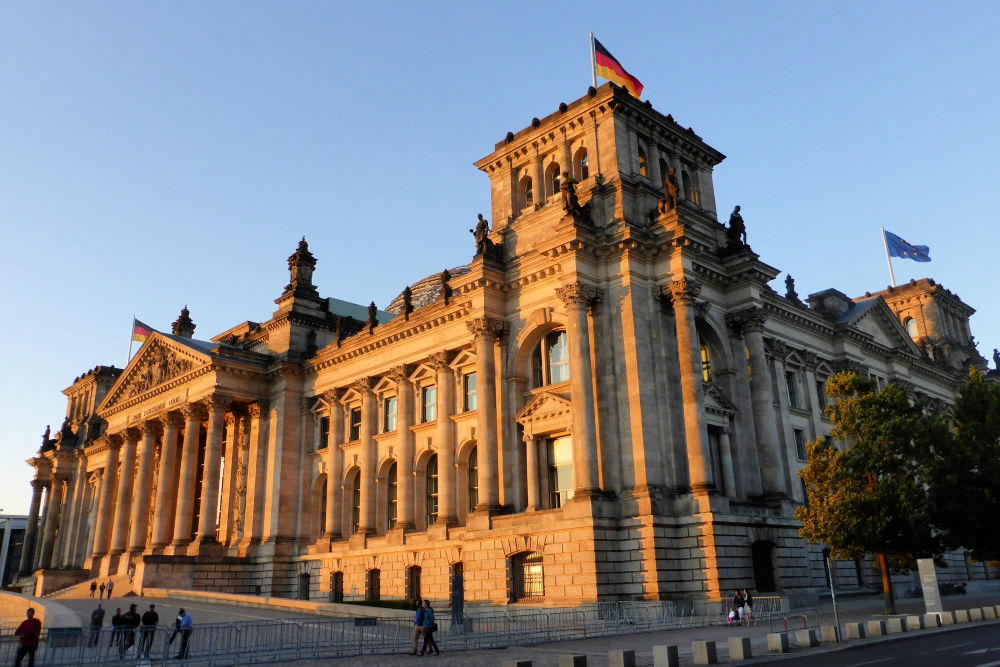
This weekend guide will get you started with suggestions for things to see and do and places to stay. To learn a little about Berlin pre-trip we recommend Rick Steves’ episode on Berlin which gives you an introduction to many of the sites mentioned in this guide and can be watched for free on his website or on YouTube or his travel guide, if you’d prefer a book you can take along with you on your trip. We hope you enjoy Berlin!
WHERE TO STAY IN BERLIN
How do you even start to pick a place to stay in Berlin? The hotel options are truly countless. In Berlin, we recommend choosing a hotel close to the main sites, for wonderful walks in the city, or near the S-Bahn for quick and easy transport around the city.
For this itinerary three options are:
SCANDIC BERLIN POTSDAMER PLATZ $ – This was a lucky find after our Airbnb host cancelled our booking the morning we were due to arrive in the city, but it turned out to be great! I was greeted by friendly staff and checked in quickly. The rooms were bright, clean, and modern with unique decor. A really nice touch was the soft music that was playing as I entered our room which just made everything feel calm and inviting. The hotel is also within walking distance to many sites, including the Reichstag and Brandenburg Gate.
BOOK YOUR STAY: Direct with Hotel | Hotels.com | Booking.com | TripAdvisor
HOTEL BRISTOL BERLIN $$ – For a touch of romance and a boutique feel, this 5-star hotel has prices starting in the mid-range and offers a beautiful pool and spa and unique room decor. There are also a couple of bars in the hotel – one with a fireplace and the other a piano – both of which would be cosy places for a nightcap to relax at the end of the day.
BOOK YOUR STAY: Direct with Hotel | Hotels.com | Booking.com | TripAdvisor
HILTON BERLIN $$$ – With a full-service spa, indoor pool, two restaurants on site and some rooms with views of the Reichstag Dome, this hotel would certainly be a little bit of luxury after your day out exploring the city. It is within walking distance of many of the sites in this weekend guide and it gets great reviews from guests.
BOOK YOUR STAY: Direct with Hotel | Hotels.com | Booking.com | TripAdvisor
If, like us, you prefer the comforts of home while on the road, an Airbnb might be ideal for you. Click to see what is available in Berlin.
NEW TO AIRBNB? Click for a discount on your first booking when you sign up for a new account.
HOW TO GET AROUND BERLIN
For getting around Berlin, we recommend the Berlin WelcomeCard which is what we used on our weekend in the city.
It includes unlimited travel on public transport either in zone AB (city centre) or ABC (city centre and surrounding areas). You can also get up to 50% discount on approximately 200 major sites and attractions (including sites in this weekend guide).
Cards can be purchased for 48 hours, 72 hours, or 4, 5, or 6 days. We purchased the 48-hour card for our weekend and it worked out well for us.
HELPFUL LINKS:
- Click to learn more about the Berlin WelcomeCard or purchase your card in advance.
- If you need an app that will navigate you around whether walking, driving or using public transport and even works offline then click for a guide about how to use Here WeGo.
THINGS TO SEE AND DO IN BERLIN
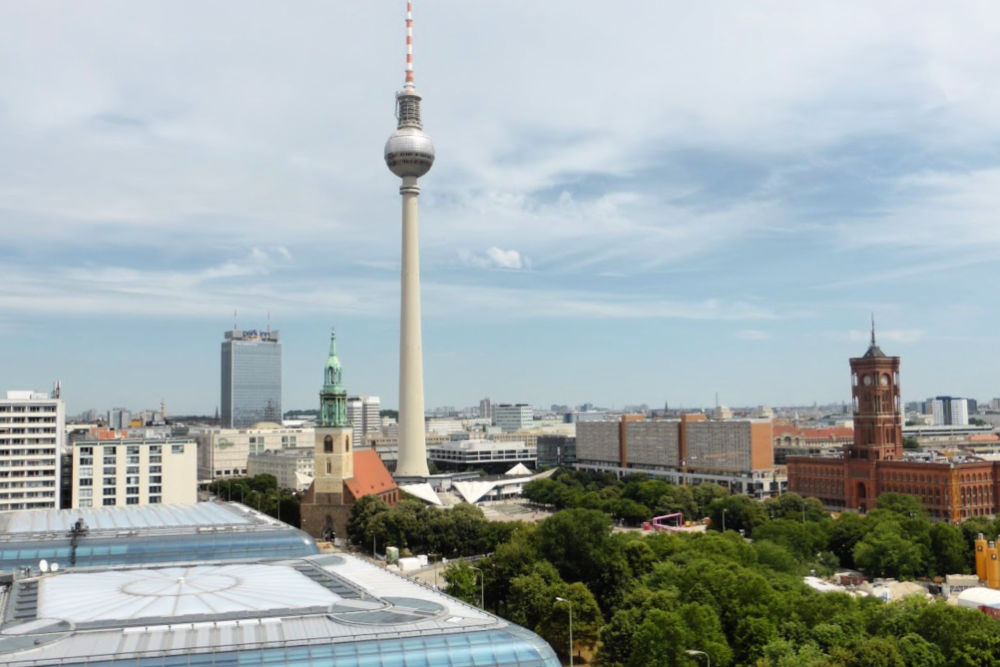
STROLL UNTER DEN LINDEN
Stretching east of the Brandenburg Gate stretches the broad and stately Unter Den Linden (Under the Lindens) which was once Berlin’s most important and elegant thoroughfare. It was lined with thousands of linden trees that were so important to the people that when Hitler replaced them with Nazi flags the public discontent actually persuaded him to replant the trees. Today we can only imagine its pre-war grandeur but it is still a beautiful stroll past important buildings (such as embassies) and little cafés enticing those passing by to stop and relax for a moment or two.
This would be a great start to a weekend in Berlin to get an overview of the city and see some of the main sites that you’ll want to visit later in the weekend. You could end your walk in the evening at the TV Tower with dinner in the restaurant 207 m above the city that revolves once per hour for 360° views.
HELPFUL LINKS:
- Learn more about how Berlin’s Unter den Linden has come back to life.
- A free Berlin City Walk by Rick Steves that includes a stroll along Unter den Linden. This can be downloaded to his Audio Europe app or listened to on a podcast. It also comes with a helpful map that can be printed off.
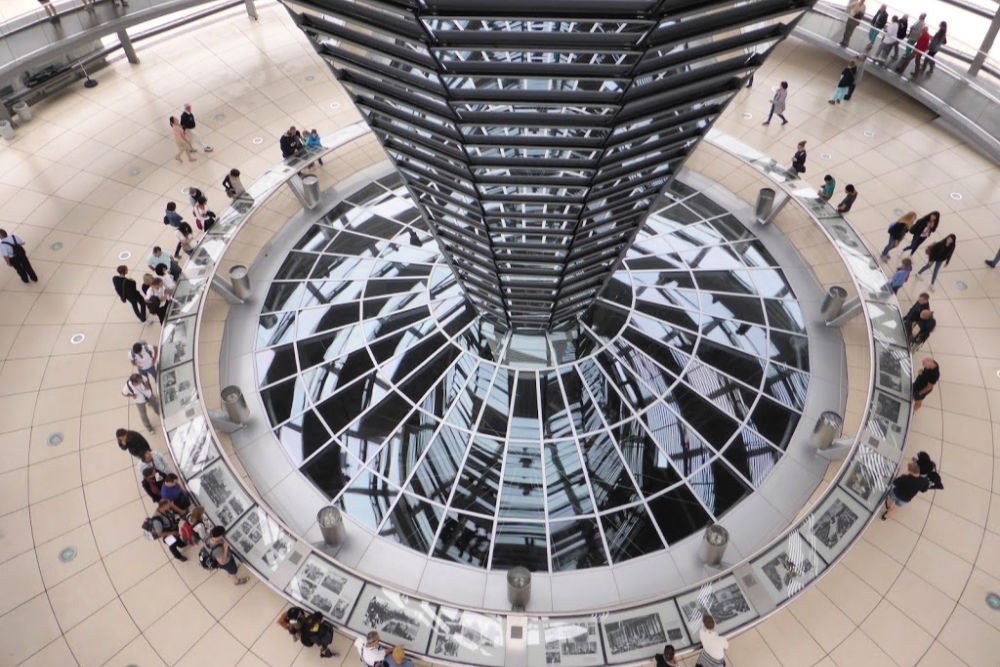
CLIMB THE DOME OF THE REICHSTAG
In our opinion, a visit to this important symbol of Germany’s history is a must-do on your trip to Berlin. Standing next door to the Brandenburg Gate, the Reichstag is the nineteen-century home of the German parliament, which was remodelled by Norman Foster in 1999 for the resumption of its historic role (after the capital of Germany moved back from Bonn to Berlin in 1991). Where the old Reichstag witnessed the dismantling of democracy, this new version is all about transparency that is very evident in the glass dome that tops it.
The planary chamber is in the centre and overlooked by the glass cupola where the public can wander around the helical ramp to the top, or stop to look down on their elected representatives.
There are wonderful views of the city from inside the dome and outside on the rooftop at the base of the dome, so it is no wonder it has become one of Berlin’s most popular sites. Because of this, even though it is free, you should book your space in advance to visit. When visiting you’ll be given use of a great audio guide that knows your location on the spiral walkway to give you accurate information about the sites you can see from where you are standing.
HELPFUL LINK:
- Register to book your space in advance online to visit the dome. If you do not book in advance you can register to visit (at least two hours in advance) at the service centre nearby next to the Berlin Pavilion but there may be limited times available, or no spots at all. It is highly recommended you register in advance.
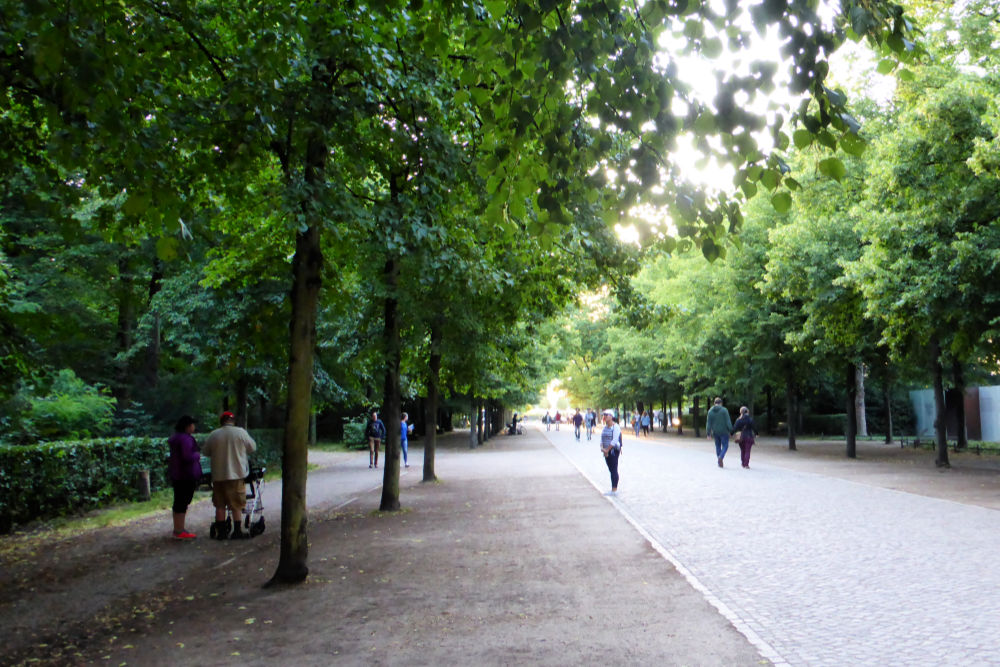
RELAX IN THE TIERGARTEN
Ideal for a stroll, picnic, or other outdoor activities, the Tiergarten is Berlin’s largest and most visited park. Situated right by the Reichstag, the park was once the hunting ground for the Electors of Brandenburg but what we see today was designed in the 1830s by Prussia’s leading landscape designer who was inspired by English gardens.
The garden was badly damaged during WWII and then it suffered even more in the wake of the war when Berliners nearly deforested the area from cutting the park’s trees down to use for heating. Thankfully in 1949, the park was replanted with trees given as donations from all over Germany.
Not only does the park offer tree-lined paths and open green spaces, but you can also find many memorials, cultural and political sights such as the Soviet War Memorial, Global Stone Peace Project, and Victory Column. In the summer visitors on a Sunday just might hear the bells played by a carillon too from the tower that soars 42 meters high with 68 bells.
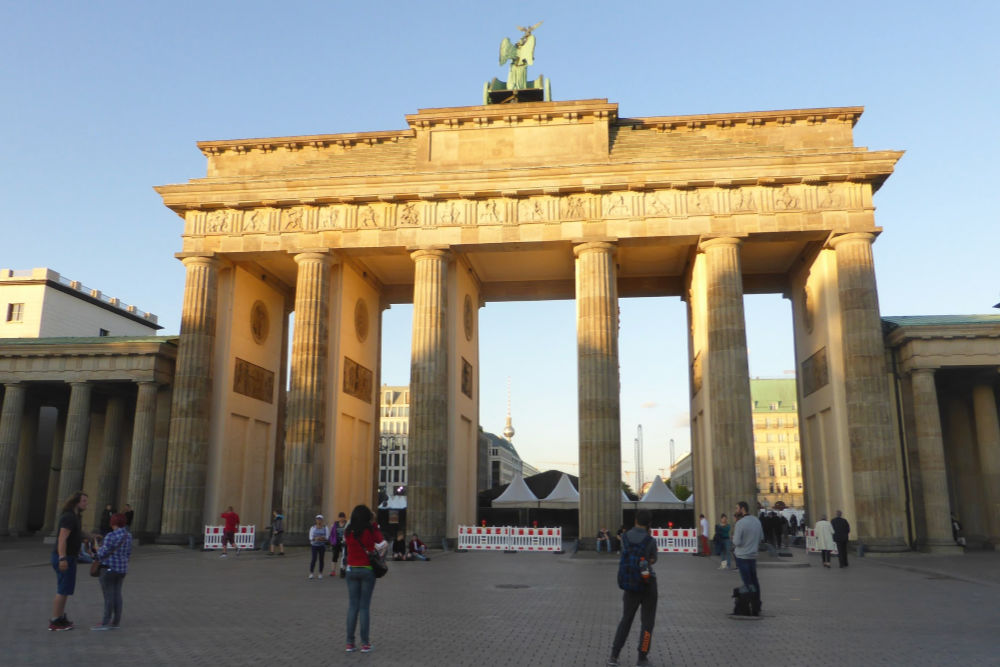
LEARN ABOUT THE HISTORY OF A DIVIDED CITY
Berlin has so many sites that can be visited if you are looking to learn more about its time spent as a divided city during the Cold War.
Starting at the heart of the city is the Brandenburg Gate that was built in the 1730s but became famous in 1961 when it became a symbol of the war with the Berlin Wall curving around it leaving it stranded in no man’s land. For nearly 30 years no one passed through it and then it was the site where Reagan famously asked Gorbachev to “…tear down this wall.” It’s now open to all to pass through and admire its grandeur and beauty.
While there are pieces of the Berlin Wall all around the city there is only one place where you can view two parallel walls plus the “death strip” between them that remains – the Berlin Wall Memorial. This memorial allows visitors to climb to a lookout platform across the street that looks down on the walls and a guard tower. Inside there is a visitor’s centre with informational exhibits and then along the street, stretching for several blocks, are plaques and images that tell the stories of escape attempts and life in the city within the wall. This is free and well worth a visit when you are in Berlin.
The site of arguably the most infamous crossing along the wall – Checkpoint Charlie – has been reconstructed and includes US “guards” that are available to take your photo with. It is very touristy but nearby is an open-air display about the wall’s history that’s less visited, but more informational.
HELPFUL LINKS:
- Berlin’s Top Cold War Locations by ‘My Guide Berlin’
- Cold War Walking Tour of Berlin
- Sandeman’s ‘Red Berlin Tour‘ explores the “people, places, and secrets that kept two worlds on the brink of WWIII and the wall that separated them”
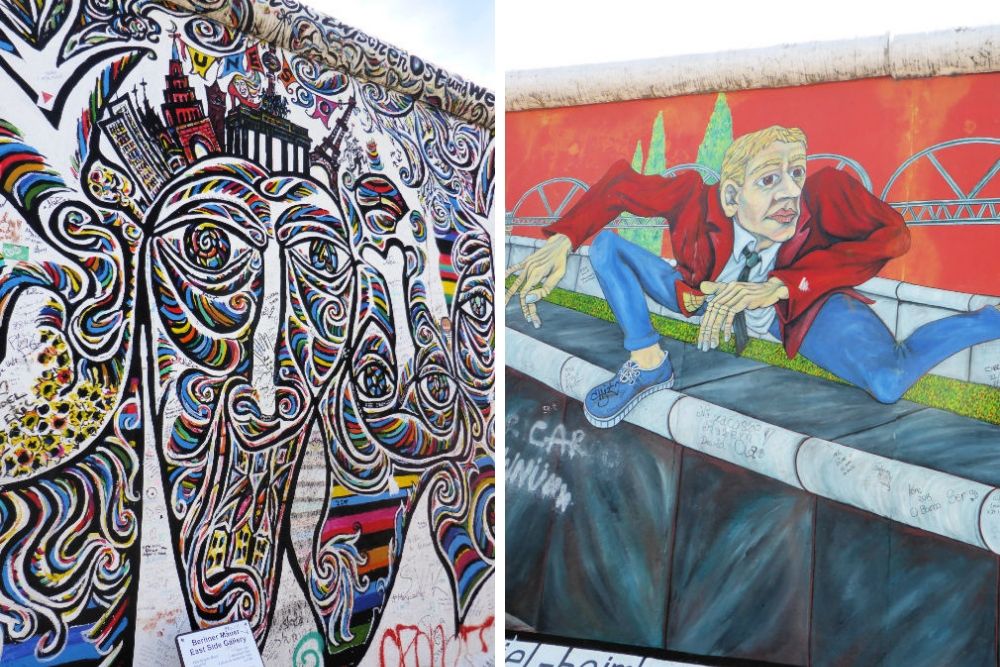
WALK ALONG THE EAST SIDE GALLERY
It has been nearly 30 years since the Berlin Wall came down and much of its course is still marked by a double row of cobblestones in places where the wall has not been left standing with informational panels at key points. Some portions of the wall have been preserved as a memorial to those who died trying to cross it.
The East Side Gallery, however, is a particularly unique part of the wall that runs along the Spree River for about 1.3 km. It is covered in paintings by more than 100 international artists, originally done in the months after the fall of the Iron Curtain to create the world’s largest open-air mural. The paintings capture the optimism of the times in a mix of political statements and drug-induced musings. Since that time many parts have been touched up or even partially fenced off, likely due to the graffiti that seems to keep making its way onto these works of art.
HELPFUL LINKS:
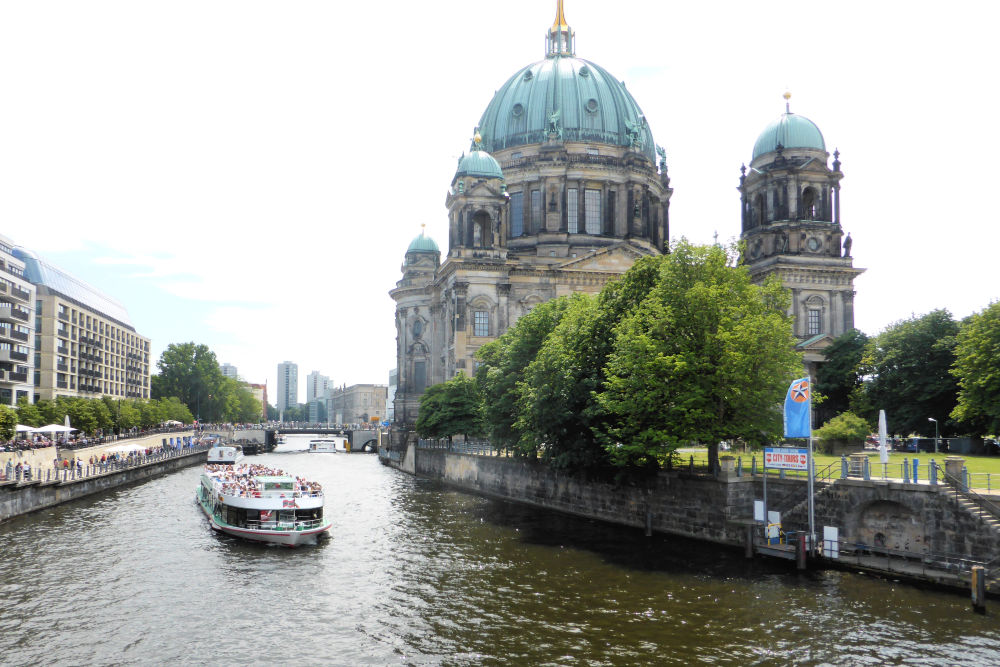
VIEW BERLIN FROM ABOVE IN THE BERLINER DOM
Situated on Museum Island along the Spree River, the Berliner Dom (Berlin Cathedral) is the city’s grandest and most important Protestant church as well as the sepulchre of the Prussian Hohenzollern dynasty. Built between 1894 and 1905, it was heavily damaged in the war and only reopened in 1993.
To say the outside needs a good clean is an understatement, compared with the gleaming stone of the Brandenburg Gate and the Reichstag, the Berliner Dom was undeniably grimy when we visited. But don’t let that put you off, because when you walk inside and see the interior, it could not be more different. Our jaws most definitely dropped at how stunning it was. We’ve deliberately not included a picture of the inside so you can experience it for yourself. Seriously don’t Google it, just see it for the first time as we did.
Inside you’ll find over ninety sarcophagi and tombs of the Prussian Kings- Friedrich I and Sophie Charlotte cast beautifully in gold-plated tin and lead. The organ has over 7,000 pipes and is one of the largest in Germany. Knowing how the singing of a boys choir filled the church during our visit we can only imagine how beautiful the organ would sound when played.
After visiting the interior you can climb the 270 steps (sometimes quite steep and narrow) to view both the interior of the church from the gallery or the river and surrounding area when walking outside around the dome.
HELPFUL LINK:
- The Berliner Dom is included in the free self-guided ‘Things to See in Berlin Mitte‘ by ‘Free Tours by Foot’.
TIP: The Berlin WelcomeCard can be used to save money on the admission to the Berliner Dom. We found this to be a convenient option, especially for the included public transport, during our time in Berlin. The Berliner Dom is also included on the Berlin Pass.
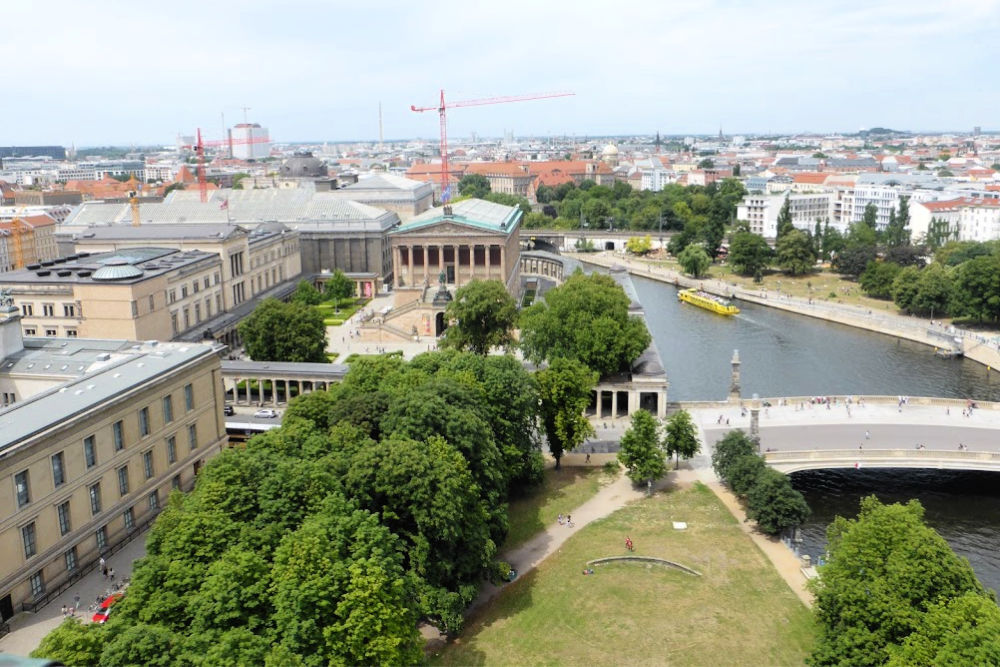
SPEND AN AFTERNOON ON MUSEUM ISLAND
Situated in the Spree River, Museum Island (Museumsinsel) houses a unique collection of galleries and museums within its five temple-like buildings. The treasures on the island span 6,000 years of human history – it’s no wonder it was given UNESCO World Heritage status in 1999.
The five museums you can visit are:
- Pergamon Museum (Pergamonmuseum): This is the largest on the island and houses the Ishtar Gate which dates back to the 6th century BC, and the Pergamon Altar from 160 BC.
- Bode- Museum: Situated at the northern tip of the island, this museum displays Byzantine art and medieval to eighteenth-century sculptures.
- New Museum (Neues Museum): Severely damaged in WWII, it remained a ruin until 1999 when it was rebuilt and refurbished. Today it holds the city’s impressive Egyptian collection which includes Berlin’s most famous exhibit – a 3,300-year-old bust of Nefertiti.
- Old National Gallery (Alte Nationalgalerie): This museum houses a collection of nineteenth-century European art.
- Old Museum (Altes Museum): Opened in 1830, this museum is the oldest on the island and focuses on Greek and Roman antiquities.
HELPFUL LINKS:
- Official Visit Berlin website where you can purchase tickets
- A brochure that includes 35 museums in Berlin that you might enjoy visiting.
TIP: To save money in Berlin, check out the Berlin Pass to see if the sights you’d like to visit are included and if it makes sense to bundle them together. All of the museums on Museum Island are included on the pass.
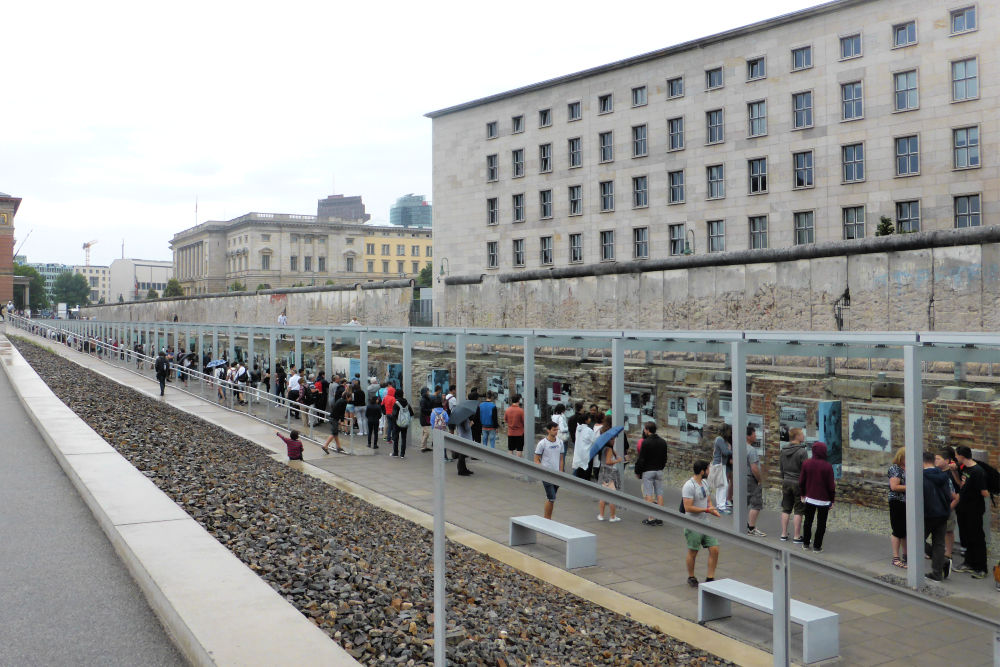
VISIT THE TOPOGRAPHY OF TERROR
The Topography of Terror is both an indoor and outdoor museum situated on the former site of the Gestapo and the SS headquarters used during the Nazi regime. The exhibitions tell the stories of their chilling histories and the crimes that were organised by these institutions in much detail. It is recommended that you allow yourself a couple of hours for a visit as there is a lot of information to read and absorb at this free museum.
The outdoor gallery is located in the trenches excavated along Niederkirchnerstrasse and focuses on Berlin’s role as the capital of the “Third Reich”. The panels describe stories of Berlin in the Weimar Republic, under the Nazis and during the war, and the consequences of the Nazi rule.
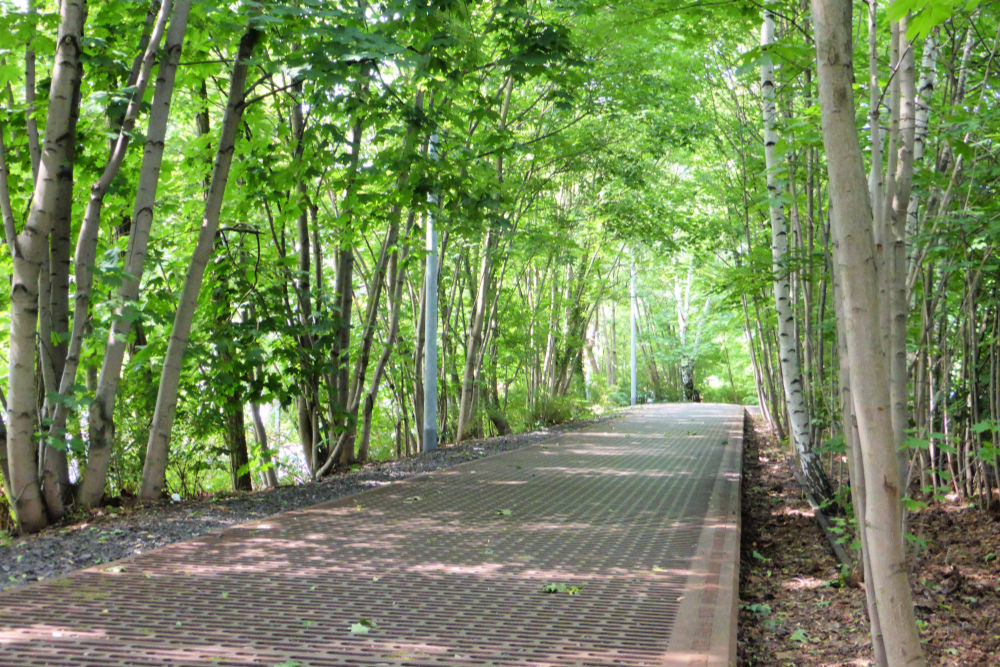
EXPLORE SOME LESSER-KNOWN SITES FROM NAZI HISTORY
In the last 100 years, few cities have had such a stormy history as Berlin so it may come as no surprise that there are so many sites with significant historical context relating to the war. Some of the sites, like the Reichstag and Memorial to the Murdered Jews of Europe, are easy to find but there are also some lesser-known sites that are worth taking some time to visit.
A few such sites include:
- Gleis 17 at Grunewald Station was the place where over 50,000 Berlin Jews were forced into railcars and then sent to ghettos or concentration camps. The memorial is made up of large iron sheets in a row with each one listing the date of transport, the number of deportees, and the final destination. The trees around the platform have been left to grow as a reminder that no train will ever depart from this platform again.
- The Führerbunker was the place Hitler and other high ranking Nazi officials worked at the end of WWII and is where Hitler and his wife committed suicide. The bunker has been demolished and today only a sign in the parking lot describes the significance of what took place here.
- Only the facade remains of Anhalter Station which was the first station that was used to deport Jews from Berlin to concentration camps. A couple of extra wagons would be hitched to the back of scheduled trains leaving for Theresienstadt; this was done 116 times and 9,600 people left Berlin from this station. Only the yellow stars on their clothing and that they were surrounded by armed guards singled them out from any other passengers boarding the train.
HELPFUL LINK:
- Berlin’s Infamous Third Reich Sites Half-Day Walking Tour
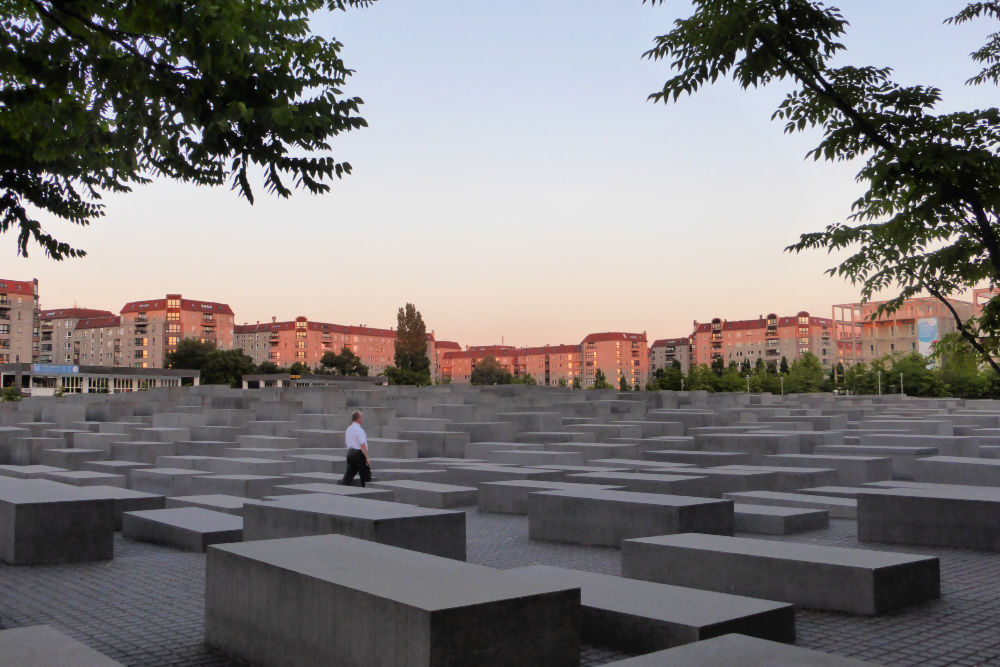
PAY YOUR RESPECTS AT HOLOCAUST MEMORIALS
Berlin and all of Germany does not shy away from the wrongs of its past and there are several monuments in the city to the victims of the Holocaust. The largest of these is the Memorial to the Murdered Jews of Europe which takes up a whole city block near the Brandenburg Gate. It is made up of 2,711 upright concrete slabs of varying heights set out in a grid pattern. The ground undulates as you walk around the site and it feels as though the pillars are growing and shrinking around you. Also on this site is an underground information centre that provides a wealth of information about the Holocaust, with some of the most moving exhibits being the personal stories and letters.
Other memorials nearby include:
- The Gay Holocaust Memorial found along the edges of the Tiergarten park. It is made of another concrete oblong form that leans to one side and has a small window behind which a film of two men kissing permanently plays. It remembers those convicted of homosexual acts under the regime.
- The Memorial to the Sinti and Roma Victims of National Socialism is found just a little to the west of the Brandenburg Gate. It is made of a pond surrounded by fragmented stones, some of which bear the name of a concentration camp. A fresh flower is placed daily on the triangular central stone (which represents the badges worn by concentration camp prisoners) in the middle of the pond.
- The T4 Memorial for the Victims of the Nazi Euthanasia Programme is at the southern end of the Tiergarten park and commemorates the approximately 300,000 people who were murdered under the Nazi’s euthanasia program that was coordinated from a building that once stood on the site.
HELPFUL LINKS:
- Sandemans walking tour – Sachsenhausen Memorial Tour– leads visitors on an informative tour of many memorial sites around the city. To reserve your spot, you can book online.
Want to save this for later? Click the Pinterest button on the left for a pinnable image!
RESOURCES | PLAN YOUR WEEKEND IN BERLIN
To book flights, rental cars, accommodations, and activities for your trip, please check out our recommended travel providers, favourite apps and websites.
- Rick Steves’ ‘Berlin‘ episode of the
TV show (whole episode) - Rick Steves Audio Europe App: With this
app, you can listen to many excerpts from his radio shows and books including a guided audio tour called “Berlin City Walk“.
These are a few tours we would recommend for your weekend in Berlin.
Some of the links in the post above are affiliate links. This means if you click on the link and purchase the item, we will receive an affiliate commission but this does not affect the price to you. Please read our full disclosure policy here.





